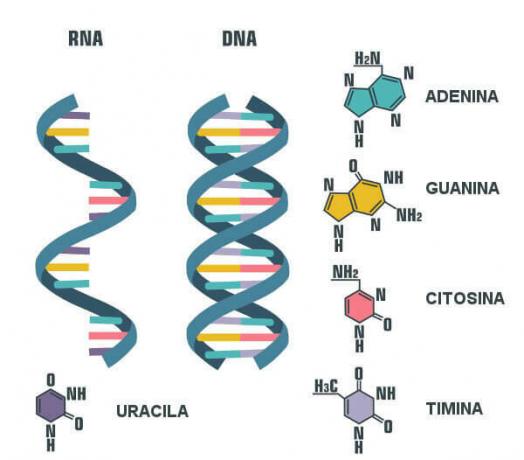O DNA (deoxyribonucleic acid) it is a type of nucleic acid that stands out for storing the genetic information of the vast majority of living beings. This molecule is made up of nucleotides and generally takes the form of a double helix. in organisms eukaryotic, DNA is found in the cell nucleus, mitochondria and chloroplasts. US prokaryotes, the DNA is located in a region that is not bounded by the membrane, called the nucleoid.
Read too: Differences between prokaryotic and eukaryotic cells
→ DNA composition
DNA is made up of nucleotides, which are made up of three parts:
A five-carbon carbohydrate (pentose)
A nitrogenous base
One or more phosphate groups
With regard to the sugar present in the DNA, the presence of a deoxyribose. Deoxyribose is a pentose which differs from ribose in having a hydroxyl unless that last sugar.

Note the different nitrogen bases present in nucleic acids. Uracil is not present in DNA.
Nitrogen bases have one or two rings, which have nitrogen atoms, and are classified into two groups.
: the pyrimidines and purines. Pyrimidines have only one six-atom ring, which is composed of carbon and nitrogen. Purines, on the other hand, have two rings: a six-atom ring fused to a ring with belt atoms. Cytosine (C), Thymine (T) and Uracil (U) are pyrimidines, while the adenine (A) and guanine (G) are purines. Of the nitrogenous bases mentioned, only uracil is not observed in DNA.→ DNA structure
DNA is formed by two polynucleotide chains (strip), which are made up of several nucleotides. The nucleotides are joined together by bonds called phosphodiester (phosphate group linking two sugars of two nucleotides). In these bonds, a phosphate group connects the 3' carbon of one sugar to the 5' carbon of the next sugar.
This joining of the nucleotides forms a typical repeating pattern of the sugar-phosphate unit, which forms the main chain. The nitrogenous bases are linked to this main chain.

Note the bonds between the nucleotides and the complementarity of the nitrogenous bases.
When looking at the free ends of a polynucleotide chain, it is noticeable that, on the one hand, we have a phosphate group attached to the 5' carbon and, on the other, we have a hydroxyl group attached to the carbon 3'. Thus, we have two ends in each chain: the 5' end and the 3' end.
The two polynucleotide chains of the DNA form a double-helix. The main chains are located in the outer portion of the helix, while inside the nitrogenous bases are observed, which are joined by hydrogen bonds. The main chains have opposite 5’ → 3’ directions, that is, one chain is in the 5' → 3’ direction, and the other, in the 3' → 5’ direction. Due to this characteristic, we say that the tapes are antiparallel.
The union between the nitrogenous bases is what makes the two chains stick together. It is worth noting that the pairing occurs between complementary bases, with the union of a pyrimidine base with a purine base. The pairing between bases only happens in the following ways:
Adenine is only paired with thymine;
Guanine is always paired with cytosine.
As the bases are specifically combined, we can conclude that, in the double helix, one chain will always be complementary to the other. Thus, if a strand has the sequence of bases 5'-ACCGTCCA-3', we will have the sequence 3'-TGGCAGGT-5' as a complementary strand. We can therefore conclude that the quantity of A is the same as T and the quantity of G is the same as C.
The model described above for the DNA molecule is the structure proposed by Watson and Crick, in the year 1953. The model they proposed can be compared to a spiral staircase, in which the nitrogenous bases would form the steps, and the sugar and phosphate chains would form the handrails.
→ DNA function
DNA is an extremely important molecule for living things. The functions of DNA are:
Store and transmit genetic information.
Function as a template for RNA molecule synthesis. DNA, therefore, is fundamental for the protein synthesis, as it contains the information that command the RNA synthesis, and the RNA coordinates the production of these polypeptides (DNA → RNA → Protein).
Read too: DNA test
→ Replication and transcription
When it comes to DNA, two processes are worth mentioning: replication and transcription. When we talk about replication, we refer to the process by which copiesidentical to the copy of a DNA molecule are formed. For this process to occur, the DNA is partially uncoiled and the synthesis of a new strand starts from the strand of DNA that will be copied. This process is considered semi-conservative, because the newly formed DNA will have a new strand and a strand of the original DNA.
The process oftranscription is the one in which the DNA is used for the formationinonemoleculeinRNA. In this process, the DNA splits open at one point, and one of the strands is used as a template for RNA synthesis. As the RNA is transcribed, the DNA is closed again.
An interesting point to be highlighted is that, during the transcription process, who pairs with the template strand adenine is the uracil, a nitrogenous base found in RNA and absent in DNA.
Read too: RNA Types
→ Difference between DNA and RNA

Note the differences between RNA and DNA.
DNA and RNA are the two types of nucleic acids found in living things. Although both are made up of nucleotide subunits linked by phosphodiester bonds, they have some basic differences. See below:
DNA has deoxyribose as a sugar, while RNA has a ribose.
The nitrogenous bases present in DNA are cytosine, guanine, adenine and thymine. In RNA, cytosine, guanine, adenine and uracil are found.
DNA is double-stranded, but RNA is single-stranded.
By Me. Vanessa Sardinha dos Santos
